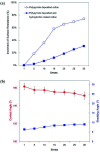Electric heated cotton fabrics with durable conductivity and self-cleaning properties
- PMID: 35548731
- PMCID: PMC9085525
- DOI: 10.1039/c8ra05530k
Electric heated cotton fabrics with durable conductivity and self-cleaning properties
Abstract
This study was carried out to improve durability and reduce conductivity degradation of polypyrrole-deposited cotton fabrics by introducting a superhydrophobic surface. An in situ polymerization method was used to polymerize the polypyrrole on the cotton fabric, and the surface energy was lowered using n-dodecyltrimethoxysilane to create a superhydrophobic surface. In particular, to investigate the durability of the conductivity according to the superhydrophobic surface, the changes of surface resistance were examined after repeated exposure to air, moisture, and friction. The polypyrrole-deposited cotton fabric displayed excellent electrical heating features originating from the conductive polymer, although the surface resistance was somewhat increased by the superhydrophobic coating. In addition, nano-roughness was obtained by the pyrrol-deposition on the fabric surface, creating a dual-roughness property required for the superhydrophobic surface. Accordingly, the conductive superhydrophobic cotton fabric had a contact angle of more than 150° and a shedding angle of less than 10°, maintaining superhydrophobicity even during electrical heating. Above all, the superhydrophobic layer contributed to the functional durability of the conductive fabrics by protecting the conductive layer. After atmospheric aging for 20 weeks, undergoing a water spray test for 20 cycles, and a rubbing test with tape, the increment of surface resistance of the superhydrophobic coated cotton fabrics with polypyrrole was increased by up to 30% compared to the polypyrrole treated specimen without the coating, which showed a decrease of conductivity of over 74%. It is confirmed that the self-cleaning properties can easily remove dirt on the cotton fabric surface by roll-off of water droplets, thereby preventing the degradation of conductivity due to moisture and contamination.
This journal is © The Royal Society of Chemistry.
Conflict of interest statement
There are no conflicts to declare.
Figures














Similar articles
-
Superhydrophobicity and conductivity of polyester-conductive fabrics using alkaline hydrolysis.RSC Adv. 2022 Aug 15;12(35):22911-22921. doi: 10.1039/d2ra03996f. eCollection 2022 Aug 10. RSC Adv. 2022. PMID: 36106007 Free PMC article.
-
Green and sustainable fabrication of a durable superhydrophobic cotton fabric with self-cleaning properties.Int J Biol Macromol. 2023 Jul 1;242(Pt 1):124731. doi: 10.1016/j.ijbiomac.2023.124731. Epub 2023 May 5. Int J Biol Macromol. 2023. PMID: 37148935
-
Durable superhydrophobic cotton fabrics prepared by surface-initiated electrochemically mediated ATRP of polyhedral vinylsilsesquioxane and subsequent fluorination via thiol-Michael addition reaction.J Colloid Interface Sci. 2021 Jul;593:79-88. doi: 10.1016/j.jcis.2021.03.006. Epub 2021 Mar 9. J Colloid Interface Sci. 2021. PMID: 33744554
-
Stearic Acid and CeO2 Nanoparticles Co-functionalized Cotton Fabric with Enhanced UV-Block, Self-Cleaning, Water-Repellent, and Antibacterial Properties.Langmuir. 2023 Aug 22;39(33):11571-11581. doi: 10.1021/acs.langmuir.3c01002. Epub 2023 Aug 7. Langmuir. 2023. PMID: 37549018
-
The Influence of Roughness on the Properties of Electroactive Polypyrrole.Molecules. 2024 Nov 18;29(22):5436. doi: 10.3390/molecules29225436. Molecules. 2024. PMID: 39598824 Free PMC article. Review.
Cited by
-
Advances in Printed Electronic Textiles.Adv Sci (Weinh). 2024 Feb;11(6):e2304140. doi: 10.1002/advs.202304140. Epub 2023 Nov 27. Adv Sci (Weinh). 2024. PMID: 38009793 Free PMC article. Review.
-
Polypyrrole-wool composite with electrical heating properties fabricated via layer-by-layer method.Sci Rep. 2024 Feb 16;14(1):3883. doi: 10.1038/s41598-024-54678-6. Sci Rep. 2024. PMID: 38366069 Free PMC article.
-
Superhydrophobicity and conductivity of polyester-conductive fabrics using alkaline hydrolysis.RSC Adv. 2022 Aug 15;12(35):22911-22921. doi: 10.1039/d2ra03996f. eCollection 2022 Aug 10. RSC Adv. 2022. PMID: 36106007 Free PMC article.
-
Progress in Flexible Electronic Textile for Heating Application: A Critical Review.Materials (Basel). 2021 Oct 30;14(21):6540. doi: 10.3390/ma14216540. Materials (Basel). 2021. PMID: 34772066 Free PMC article. Review.
-
Integration of Polypyrrole Electrode into Piezoelectric PVDF Energy Harvester with Improved Adhesion and Over-Oxidation Resistance.Polymers (Basel). 2019 Jun 21;11(6):1071. doi: 10.3390/polym11061071. Polymers (Basel). 2019. PMID: 31234306 Free PMC article.
References
-
- Liu Y. Zhao X. Tuo X. J. Text. Inst. 2017;108:829–834. doi: 10.1080/00405000.2016.1193981. - DOI
-
- Sasso C. Beneventi D. Zeno E. Chaussy D. Petit-Conil M. Belgacem N. BioResources. 2011;6:3585–3620.
-
- Dias T., Electronic textiles: smart fabrics and wearable technology, Cambridge, 2016
-
- Macasaquit A. C. Binag C. A. Philipp. J. Sci. 2010;139:189–196.
-
- Wu J. Zhou D. Too C. O. Wallace G. G. Synth. Met. 2005;155:698–701. doi: 10.1016/j.synthmet.2005.08.032. - DOI
LinkOut - more resources
Full Text Sources

